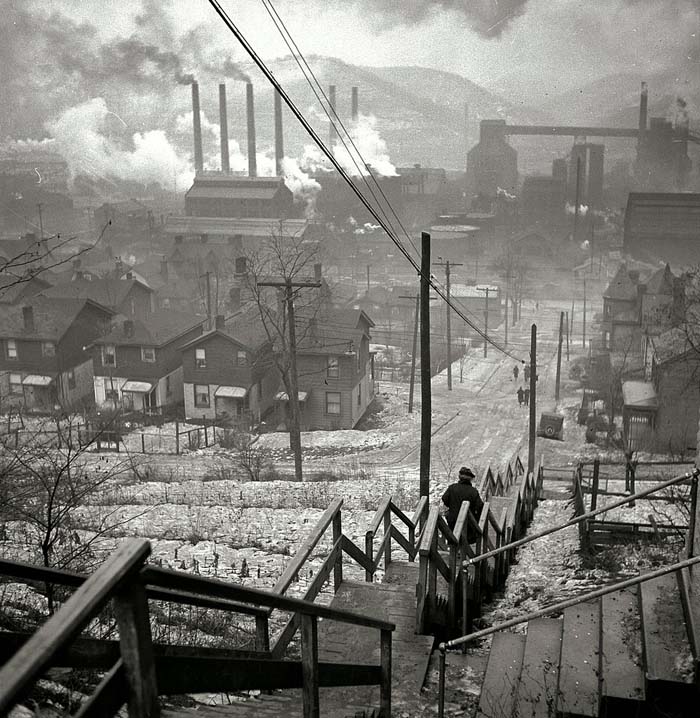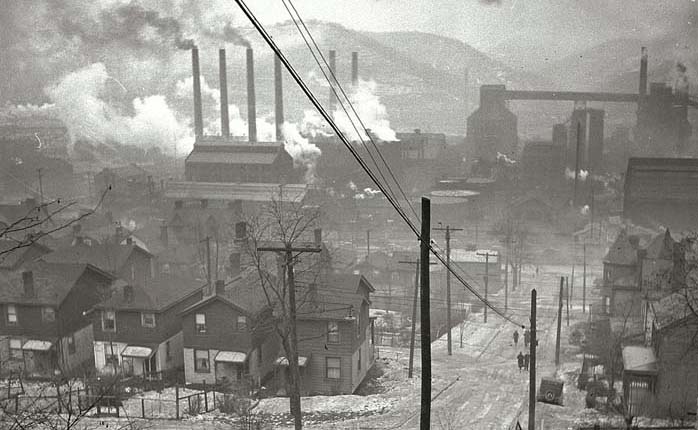
Steel mills and a long staircase in the South Side Slopes neighborhood of Pittsburgh, Pennsylvania. On our way to Making Air and Water Great Again. A commons image.
It could actually increase air pollution, and it’s a pretty bad deal
By David Roberts / VOX / August 19, 2019
 [dropcap]I[/dropcap]n June, the Trump administration unveiled its proposed replacement for the Clean Power Plan, Obama’s program to reduce greenhouse gas emissions from existing power plants. Last week, a coalition of 29 states and cities filed a lawsuit to block the rule, claiming that it violates Trump’s obligations under the Clean Air Act.
[dropcap]I[/dropcap]n June, the Trump administration unveiled its proposed replacement for the Clean Power Plan, Obama’s program to reduce greenhouse gas emissions from existing power plants. Last week, a coalition of 29 states and cities filed a lawsuit to block the rule, claiming that it violates Trump’s obligations under the Clean Air Act.
And on Sunday, nonpartisan research firm Resources for the Future, along with researchers from the Harvard T.H. Chan School of Public Health, Syracuse University, and the Boston University School of Public Health, released new research showing that even Environmental Protection Agency’s meager projected pollution reductions from its rule are likely overestimated.
The story of EPA carbon regulations is long and tangled, but if you’re in a hurry, here’s the short version:
The president’s plan is the bare minimum the EPA thinks it can get away with. It won’t reduce emissions much; in fact, it is likely to increase both carbon dioxide and local air pollutants, along with their health impacts, in more than a dozen states. (Seriously.) And the EPA is going to have a hell of a time justifying it to a court.
Now let’s walk through the longer version of the story. Most coverage so far has focused on the plan’s striking weakness (for obvious reasons), but there are several other aspects of the fight over power plant emissions that are worth understanding. How these policy and legal questions get resolved will have enormous influence on what the next administration — if we ever make it to another administration — can do to address climate change.
So, with that in mind, here are the six things you need to know about Trump’s Affordable Clean Energy (ACE) plan.
Trump’s EPA is regulating carbon because it has to, not because it wants to
The Trump administration has repeatedly expressed skepticism toward climate change, hostility toward regulation, and an all-consuming hatred for anything with former President Barack Obama’s fingerprints on it. If it had its druthers, it wouldn’t regulate carbon emissions at all.
But it has to. In 2007’s Massachusetts v. EPA, the Supreme Court ruled that if the EPA finds that greenhouse gases are a threat to public health, it must regulate them as air pollutants under the Clean Air Act. In 2009’s Endangerment Finding, the EPA found that, yes, greenhouse gases are a danger to public health.
Those twin developments created a set of legal obligations for the agency. It must:
- regulate mobile sources of greenhouse gases, i.e., vehicles — that was Obama’s fuel economy standards, which Trump is busy gutting;
- regulate new stationary sources of greenhouse gases, i.e., power plants and refineries — that was Obama’s 2013 limits on new sources, which Trump is busy gutting;
- regulate existing stationary sources of greenhouse gases — that was the Clean Power Plan (CPP), which Trump is now gutting.
Some of the wackier denialists in the conservative coalition were pressing the EPA to challenge the endangerment finding (and former Administrator Scott Pruitt considered it). If successful, that would negate all these obligations. But, perhaps perceiving how futile and silly such an effort would be, the EPA elected not to.






